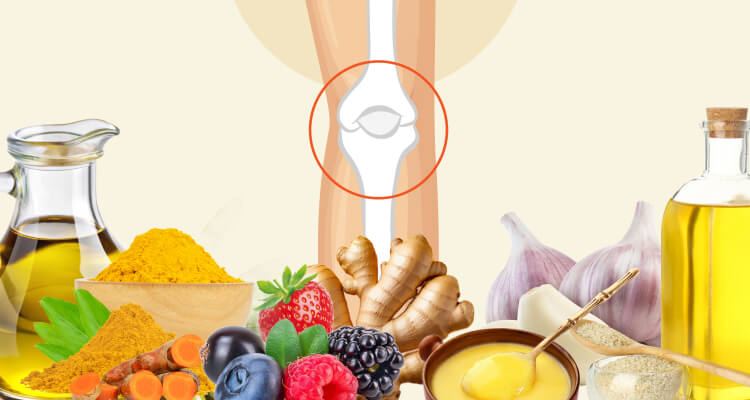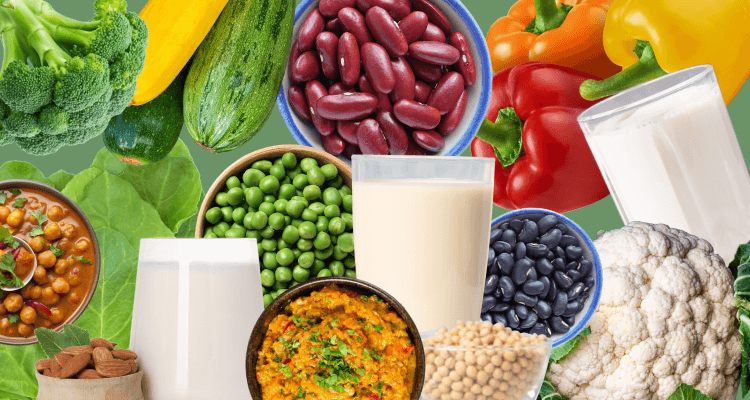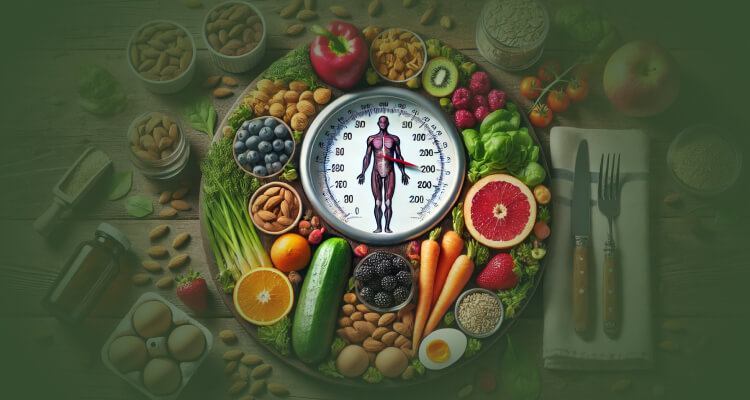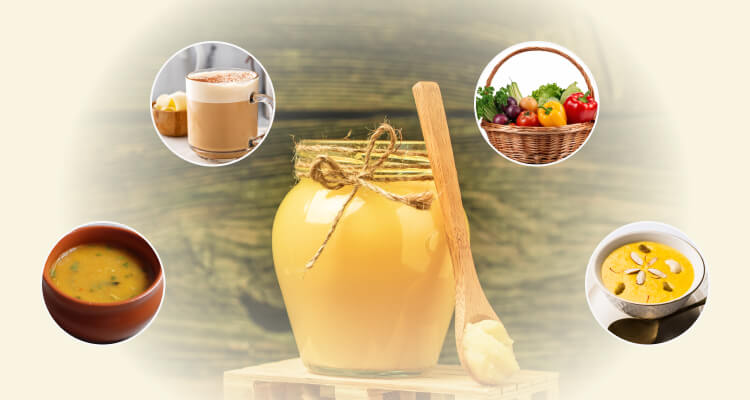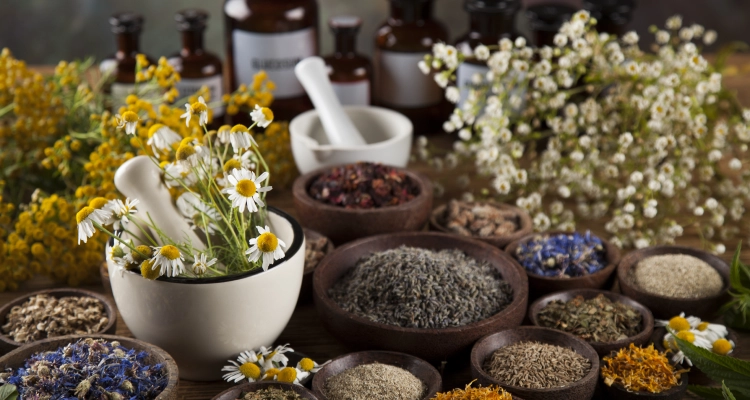“Na ca āhāra-samām kiñcit bhaiṣajyam upalabhyate”
– Kashyap Samhita, Khilasthan, 4/5
“There is no greater medicine than food!”
Arthritis is a broad term that refers to a group of over 100 conditions that affect the joints, causing inflammation, pain, stiffness, and sometimes swelling. The most common types of arthritis are osteoarthritis (OA) and rheumatoid arthritis (RA), though there are several other forms, including psoriatic arthritis and gout.
Inflammation is the key feature of arthritis and drives much of the pain experienced by the 58 million adults in the U.S. living with arthritis—a number that continues to grow.
Ayurveda, a holistic health system with roots over 5,000 years ago, links joint pain to an imbalance in the body’s natural energy types—known as doshas. When these doshas are disrupted, they can lead to dryness and stiffness in the joints. Modern research echoes these insights, showing that anti-inflammatory foods can significantly reduce inflammation and support joint health, bringing both science and tradition together for a natural approach to joint care.
Let’s examine each food item in detail, focusing on its benefits, along with easy and delicious ways to include in your meals for better joint comfort.
Turmeric – Known for its healing properties
Turmeric is well-known for its bitter, pungent taste and its ability to promote dryness and lightness in the body. It’s a natural detoxifier that can help boost the immune system.
Due to its warming properties, turmeric helps balance Kapha (the bioenergy associated with structure and stability) and Vata dosha (the bioenergy responsible for movement and circulation), aiding in the removal of toxins and supporting tissue repair.
It also helps harmonize Pitta dosha (the bioenergy related to digestion and transformation), which supports healthy digestion, reduces inflammation, and helps balance Vata, making it particularly useful for managing pain and discomfort, especially in conditions like arthritis.

Research indicates curcumin present in turmeric can significantly reduce joint pain and enhance movement, particularly in osteoarthritis and rheumatoid arthritis. In some studies, arthritis patients who took curcumin supplements reported around 50% reduction in pain and stiffness, making turmeric a promising adjunct therapy for pain relief.
With its potential for both short-term pain relief and long-term joint support, turmeric is highly regarded in both traditional and modern medical fields as an effective natural remedy.
How to Use:
- Turmeric Milk: Make golden milk by mixing 1/2 teaspoon of turmeric powder with warm milk (dairy or plant-based), and add a pinch of black pepper (to enhance absorption) and a bit of honey or cinnamon for taste. Sip before bed to ease inflammation.
- In Meals: Add a teaspoon of turmeric powder to curries, soups, or stews. Its warm flavor complements many dishes, especially when combined with other spices like cumin or coriander.
Ginger – Famous for its soothing effects
In Ayurveda, ginger is valued for its ability to reduce rigidity and balance Vata and Kapha doshas. It improves digestion and circulation, which are crucial for alleviating joint pain and supporting joint function.
The antioxidants in ginger help combat oxidative stress, a major contributor to chronic inflammation. Oxidative stress can exacerbate joint damage and speed up aging, making ginger’s antioxidant properties helpful for pain relief and long-term joint health.

Ginger’s immune-modulating effects can be beneficial for individuals with autoimmune forms of arthritis, like rheumatoid arthritis, where immune regulation is important for reducing flare-ups and joint damage.
How to use:
- Ginger-infused water: Steep a few slices of fresh ginger in hot water for 5 to 10 minutes on an empty stomach in the morning. Add honey and lemon for flavor, if desired.
- In Meals: Use grated or sliced ginger in stir-fries, soups, or curries.
- Smoothie Addition: Add a small piece of fresh ginger or a pinch of ginger powder to smoothies for a zesty kick and digestive support.
- Ginger Slices: Or, simply eat a few thin slices with salt as an appetizer.
Ghee – Revered for its nourishing qualities
Ghee, or clarified butter, is a foundational Ayurvedic ingredient known as a yogavahi (bioavailability enhancer), meaning it enhances the healing effects of herbs and spices. Ghee is abundant in vitamins A, E, and K2, which support joint lubrication, reduce stiffness, and promote bone health. It also contains butyrate, a fatty acid known for its soothing properties.

Research has shown that ghee’s butyrate can help manage chronic inflammation and reduce oxidative stress, which benefits joint health.
How to Use:
- Cooking Oil Substitute: For sautéing vegetables or cooking grains, use ghee instead of butter or oil. It has a high smoke point, making it ideal for high-heat cooking, and it enhances the absorption of nutrients and medicinal properties from other ingredients.
- On Toast or in Oatmeal: Spread a small amount of ghee on whole-grain toast or stir it into warm oatmeal. Ghee contains healthy fats that help cushion the joints and promote better digestion.
- Ghee in Golden Milk: Add a teaspoon of ghee to your turmeric golden milk. Ghee enhances the absorption of turmeric’s curcumin, amplifying its nourishing benefits.
Olive Oil – Known for its hydrating benefits
Olive oil, especially extra virgin olive oil, contains oleocanthal, a compound with strong anti-inflammatory effects similar to ibuprofen. Studies show that oleocanthal inhibits the COX-1 and COX-2 enzymes, which are key players in the inflammatory process.
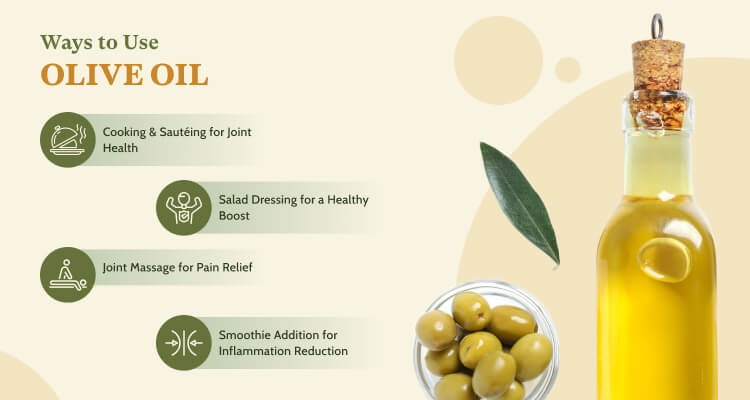
Olive oil is high in monounsaturated fats, particularly oleic acid, which can reduce joint inflammation and may improve symptoms of rheumatoid arthritis and osteoarthritis. Omega-9 fats also help support cell membrane integrity, which is essential for joint flexibility and comfort. Olive oil’s cardiovascular benefits are well-documented, supporting better circulation and overall tissue nourishment.
How to Use:
- Cooking and Sautéing: Use extra virgin olive oil as your primary cooking oil for sautéing vegetables, grains, and lean proteins. It has the ability to reduce swelling and irritation, particularly when used consistently.
- Salad Dressing: Make a simple, heart-healthy dressing by mixing olive oil with balsamic vinegar, lemon juice, and your favorite herbs. It’s a great way to add more olive oil to your diet.
- Joint Massage: Gently massage warm olive oil onto painful or stiff joints. Its antioxidants and oleocanthal compounds can help relieve discomfort.
Sesame Oil – Celebrated for its Restorative Properties
According to Ayurveda, sesame seeds are sweet, pungent, astringent, and bitter, with a heating effect on the body. Its warm, oily qualities are especially balancing for Vata dosha (bioenergy responsible for movement and circulation). Additionally, the heating nature of sesame makes it beneficial for Kapha dosha (bioenergy associated with structure and stability), helping to reduce excess moisture and promote balance.

Sesame oil contains sesamol and sesaminol, two antioxidants that have demonstrated inflammation-soothing effects. Sesame oil is especially beneficial for reducing stiffness and improving mobility in joints. Sesame oil is high in omega-6 fatty acids, which help support tissue repair. Sesame oil contains small amounts of calcium and magnesium that support bone density and muscle relaxation.
How to use:
- Sesame Oil Smoothie Boost: Add a teaspoon of sesame oil to your morning smoothie. It provides healthy fats that support joint lubrication and overall mobility, especially when combined with anti-inflammatory fruits like berries.
- Warm Sesame Oil Drink: Stir 1/2 teaspoon of sesame oil into warm water or herbal tea. This soothing drink helps promote digestion and provides joint-supporting nutrients, as well as aids proper bowel movements and helps in calming Vata.
- Joint Massage: Warm sesame oil slightly and massage it directly into sore or stiff joints. Its warming and penetrating properties can help ease discomfort while improving circulation to the area.
- Aromatherapy Blends: Mix sesame oil with essential oils like eucalyptus or lavender for a calming, anti-swelling massage that targets joint pain.
Berries– Packed with antioxidants
Berries such as Indian gooseberry (amla), blueberries, strawberries, and raspberries are rich in anthocyanins and vitamin C, known for their antioxidant properties. In Ayurveda, certain berries like Indian gooseberry are considered tridoshic (suitable for all body types), making it an ideal choice for most people. They’re also beneficial for cooling the Pitta dosha.

How to Use:
- Snack on Fresh or Dried Berries: Enjoy a handful of blueberries, strawberries, or raspberries between meals. Ayurveda recommends avoiding dairy with berries for optimal digestion.
- Berry Sauce for Desserts: Lightly heat mixed berries in a pan to make a quick sauce for drizzling over chia pudding or toast. It preserves antioxidants while creating a sweet, low-sugar treat.
Garlic – Known for Alleviating Inflammation in Arthritis
Garlic’s role in treating Vata-related disorders (Vataroga) including arthritis makes it a great addition to an arthritis diet. Ayurveda has high regard for garlic as a medicine. Garlic can help with arthritis symptoms because it contains an anti-inflammatory compound that may reduce inflammation and cartilage damage.

It is hot and intense and has the special feature of possessing 5 of the 6 tastes mentioned in Ayurvedic medicine: pungent, sweet, bitter, astringent, and sour. Its warming nature makes it particularly useful for balancing Vata (responsible for movement and circulation), and to reduce pain, stiffness, and inflammation caused by arthritis.
How to Use:
- Garlic-Infused Milk (Lasuna Kshirpaka) – It is a special Ayurvedic recipe where garlic is cooked with milk through a specific process. It’s known for helping with joint and bone health, improving digestion, and managing Vata imbalances. The milk makes it easier to digest, and it’s gentler on the stomach than raw garlic. It’s a great way to include garlic in your daily routine
- Cooked Garlic – You can also add cooked garlic to your meals. Roasting, chopping, or sautéing garlic before adding it to soups, salads, or sauces makes it easier to digest while still providing its health benefits.
Embrace Nature’s Healing Power for Joint Health
Managing joint pain and inflammation doesn’t have to mean relying solely on pharmaceuticals. Just as the body requires the right nutrients, it needs time, patience, and care to heal. By choosing natural foods and remedies, you support long-term wellness and take steps toward a healthier, more vibrant future.
At LYBL, we solve the need for a trustworthy, integrative health solution that blends traditional Ayurveda with modern science. We address today’s most common health challenges—such as arthritis, anxiety, digestive issues, insomnia, and more—offering personalized, evidence-based protocols that complement conventional medicine. With precisely formulated supplements, customized diet and lifestyle recommendations, and yoga modules, LYBL provides step-by-step guidance, making optimal health both accessible and achievable.
Let LYBL support you on your journey to better health, combining the wisdom of Ayurveda with cutting-edge technology for lasting wellness.

